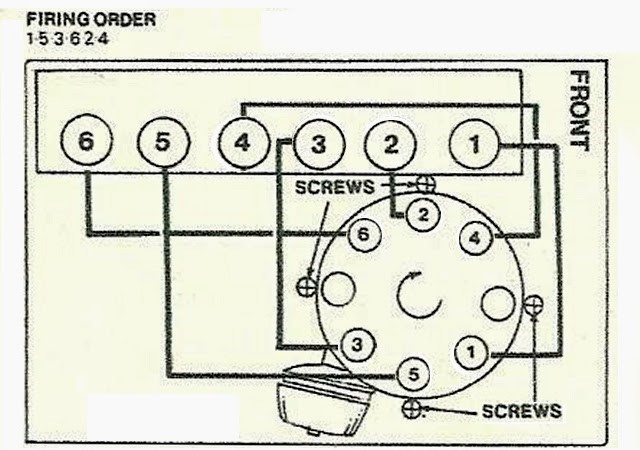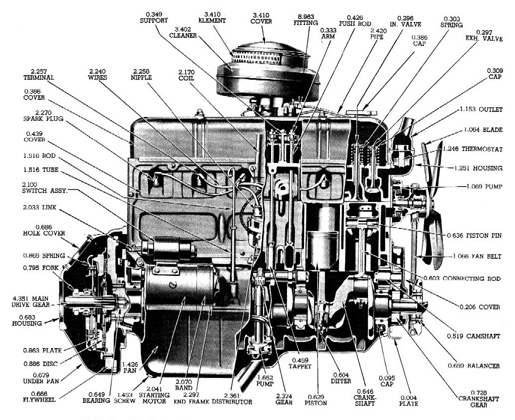The Chevy 6-cylinder engine is widely regarded as one of the most powerful automotive engines ever produced by a company based in the United States. The 235, which was lauded for its exceptional power and longevity, was used in certain variants of both the Chevrolet and the GMC.
When it was originally made available to the public in 1941, the Chevrolet 235 6-cylinder engine found its primary use in heavy trucks. General Motors began installing the engine in a large number of its vehicles that were to be equipped with the Powerglide automatic car in the year 1950. After another 4 years, most Chevy engines which were mated to Powerglide transmission lines were modified to include automatic rollers and a fully pressurised lubrication system. These improvements were made.
1-5-3-6-2-4 is the correct firing sequence for a 6-cylinder Chevy, and also the timing must be set at 4 degrees BTDC. The cylinders are labelled starting from the front and working their way backwards. In addition, the Chevy powertrain was utilized in the very first production run of Corvettes, which took place between 1953 and 1955.
Throughout 1962, General Motors managed to use the engine in their trucks. However, in that year, the corporation decided to stop utilising it in favour of the brand-new Chevrolet 230 I6 engine. A tune-up for the 235 is required.
Chevy 235 Firing Order
- Firing Order: 1-5-3-6-2-4
Explanation of Chevy 235 Firing Order

The diagram of 6 cylinders 235 firing order which is 1-5-3-6-2-4 indicates that the number 1 cylinder is the 1st cylinder to be ignited, followed by cylinder number 5, as well as until you reach the number 6 cylinder. If you can memorize the stove bolt firing order for your Chevy, it will be much easier for you to detect problems that occur inside your Chevy engine and do any required minor repairs on your own.
The fundamental criterion that determines the order in which the cylinders of an internal combustion engine in a Chevy will be ignited is the physical positioning of the cylinders inside the engine. The cylinders are numbered one through six, and the following is the correct order in which to fire them while using the machine: 1-5-3-6-2-4.
When determining the Chevy spark plug gap, the firing sequence of the 235 coil wiring is a very significant factor to consider. If you get the firing sequence wrong, your engine won’t run as smoothly or efficiently as it otherwise might, which is the primary reason why it’s so important to get it right in the first place.
Firing Order Applies to:
- Chevy Trailblazer.
- Chevy Equinox.
- Chevy Traverse.
- Chevy Suburban.
- Chevy Colorado.
Torque Specifications
| Fastener Type | Torque Spec |
|---|---|
| 7/16 in. Outer Main Cap Bolt | 65 ft.-lbs. |
| 7/16 in. Inner Main Cap Bolt | 70 ft.-lbs. |
| 3/8 in. Outer Main Cap Bolt | 40 ft.-lbs. |
| 11/32 in. Connecting Rod Bolt | 38-44 ft.-lbs. |
| 3/8 in. Connecting Rod Bolt | 40-45 ft,-lbs. |
Firing Order For Similar Vehicles:
- Nissan RB26DETT – Nissan Skyline GT-R32. 1-5-3-6-2-4
- 3M Inline-Six – Toyota 2000GT. 1-5-3-6-2-4
- Honda J35 V6 – Honda Accord, Odyssey & Ridgeline. 1-5-3-6-2-4
- Honda C30A/C32B V6 – Honda/Acura NSX. 1-5-3-6-2-4
- 2JZ-GTE Inline-Six – Toyota Supra. 1-5-3-6-2-4
Was the Chevy 235 a good engine?

Between 1956 and 1962, every single one of the 235 engines that were used in automobiles was equipped with hydraulic lifters. The 235 is recognized as one of the best engines produced by Chevrolet due to its impressive power and long-lasting nature. In 1962, it was taken out in favour of the 3rd generation 230, which took its place. The points and condenser of the Chevy are quite comparable to those of other Chevrolet models, particularly those with 12 cylinders.
How much HP does a Chevy 235 have?

It was a 235-cubic-inch V6. It had an output somewhere between 110 and 150 hp and was the default option on a wide variety of Chevrolet automobiles for several years. It is among the engines that have the potential to endure the longest in history. In 1962, Chevrolet started the process of discontinuing production of the 235 engine.
This was the final year that it was manufactured for use in automobiles in North America, while the year 1962 marked the beginning of its phase-out worldwide. Chevy’s iconic and well-liked engine continues to be one of the brand’s most iconic and popular models to this day.
How can you tell the difference between a Chevy 235 and a 261 motor?
Later 235s and 261s between the years 1954 and 1962 have a small side cover which doesn’t reach as far as the ignition system, as well as the valve cover, which is held in place by four screws that are arranged around the outside edge of the cover. Casting markers in the form of elevated “captain’s bars” may be seen in the 261’s block, located right in front of the starters.
- 2007 Toyota Camry Firing Order (With Diagram) - February 2, 2024
- 2008 Honda Accord Firing Order (With Diagram) - February 2, 2024
- 2001 Honda Accord Firing Order (With Diagram) - February 2, 2024


![Duramax Years to Avoid [Best & Worst Time Period] Duramax Years to Avoid](https://nerdycar.com/wp-content/uploads/2022/06/1600px-2019_gmc_sierra_at4_6.6l_duramax_front_nyias_2019.jpg)
![15 Best Nerdy & Geeky Cars of 2024 [Ideas & Images] Nerdy cars](https://nerdycar.com/wp-content/uploads/2022/08/Nerdy-cars-150x150.jpg)
![Chevy Equinox Years to Avoid [Best & Worst] Chevy Equinox Years to Avoid](https://nerdycar.com/wp-content/uploads/2022/06/2011-Chevrolet-Equinox-Used-Chevy-SUVs-For-Sale-In-Indianapolis-IN.jpg)
![Small Block Chevy Firing Order [With Diagram] Small Block Chevy Firing Order](https://nerdycar.com/wp-content/uploads/2022/06/main-qimg-5aa485bc1e13d73ad64783d096244b57-pjlq-1.jpg)
![Chevy 350 SBC Firing Order [Explained with Diagram] SBC Firing Order](https://nerdycar.com/wp-content/uploads/2022/06/maxresdefault-3.jpg)
![GMC Acadia Years to Avoid [Best & Worst] GMC Acadia Years to Avoid](https://nerdycar.com/wp-content/uploads/2023/05/2023-GMC-Acadia-Exterior-150x150.webp)